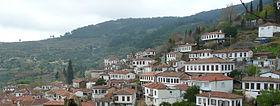Şirince
| Şirince | ||||
|
||||
 View to the south of Şirince, coming from Selçuk |
||||
| Basic data | ||||
|---|---|---|---|---|
| Province (il) : | Izmir | |||
| Coordinates : | 37 ° 56 ' N , 27 ° 26' E | |||
| Height : | 350 m | |||
| Residents : | 530 (2012) | |||
| Telephone code : | (+90) | |||
| Postal code : | 35920 | |||
| License plate : | 35 | |||
| Structure and administration (status: 2014) | ||||
| Mayor Muhtar : | Levent Opak (since 2009) | |||
| Postal address : | Şirince Köyü |
|||
Şirince is a village (Turkish: köy ) in the district (Turkish: i̇lçe ) Selçuk in the Turkish province of Izmir . With its 530 (2012) inhabitants, it is about eight kilometers east of Selçuk and historical Ephesus at the end of an olive valley on the western edge of the Aydın Mountains.
history
There are different stories about the origins of Şirince and the naming. The place was probably founded by the Ephesians with the name Solmissos, who gave up their city when they were conquered by Timur and withdrew to the mountains. Another version tells of Greek slaves who settled there and baptized the place Çirkince (Turkish for ugliness) in order to deter more settlers. In the third variant, there are 40 freed slaves, after whom the place was originally named Kırkinca (Turkish forty: kırk ; forty, or Greek "saránta", 40).
In the 19th century the place was known for its figs, most of which were exported to Europe.
Until 1924, mainly Christian Greeks lived in today's Şirince. At that time the city was much larger and an important trading center for the surrounding monasteries. Şirince was also a religious center. It was said that the Virgin Mary ascended to heaven there. After the Greco-Turkish War 1919–1922, there was a large resettlement campaign. The Greeks were expelled from Şirince and Turks who had been expelled from the area of Thessaloniki and Kavala moved in.
In 1926, the then governor of Izmir, Kazım Dirik, gave the place the new name Şirince (Turkish for friendliness).
Residents
The number of inhabitants fell as a result of the rural exodus towards Izmir from approx. 3,000 inhabitants in 1950 to 550 (2012). The population has been stabilized by the newly created jobs in tourism. In the summer months the population increases to 1,500, mainly due to Turkish second homes.
| date | Residents (main residences) |
|---|---|
| 1950 | 3000 |
| 1985 | 828 |
| 1990 | 787 |
| 2000 | 686 |
| 2010 | 565 |
| 2011 | 536 |
| 2012 | 530 |
traffic
Şirince can only be reached via a narrow mountainous country road that leads to the district town of Selçuk, just under eight km away. There is a shared taxi system (Dolmuş) to Selçuk. The provincial capital Izmir is 83 km away.
Economy and tourism
The inhabitants live mainly from viticulture and fruit growing (olives, cherries, apples, peaches, figs, walnuts) and from tourism. Şirince is considered to be an authentic old Greek village. In fact, the village image has hardly changed in the last hundred years. Most of the white brick Greek houses were built in the 18th and 19th centuries. The place is a listed building and the renovation of some of the first houses has started. The village is therefore a popular excursion destination on tours and with cruise passengers; so Şirince is often overrun with tourists in the summer months. Since the place is located on a steep mountain slope and only has small alleys, it is best to explore on foot.
The new residents have resumed the tradition of Greek viticulture; Mainly simple red wines and fruit wines are produced and sold locally. German winemakers have also been involved in Şirince since 2011. The winemaker Erkan Önoğlu caused a national sensation, who produced a special wine called the Assumption of the Holy Mother Mary for the planned end of the world (see below) .
At the end of 2012 the village experienced a rush of visitors because some believed that after the end of the Mayan calendar the world would end, but that Şirince was the only place (besides Bugarach ) to be spared due to the devotion to Mary and “positive energies” .
gallery
Individual evidence
- ^ Turkish Institute for Statistics ( Memento of December 11, 2013 in the Internet Archive ), accessed February 3, 2013
- ↑ Statistics 2012 ( Memento from December 11, 2013 in the Internet Archive )
- ^ Anatolic index
- ^ Turkey , Lonely Planet, ISBN 978-3-8297-1646-8
- ↑ Plaque at the Church of St. John in Şirince (in Turkish and English)
- ↑ http://www.yerelnet.org.tr/koyler/koy.php?koyid=249623
- ↑ Archive link ( Memento from April 13, 2014 in the Internet Archive )
- ↑ http://www.tagesspiegel.de/weltspiegel/21-dezember-weltuntergang-die-letzt-zuflucht-gende-in-der-tuerkei/7528752.html , accessed on February 2, 2013
Web links







